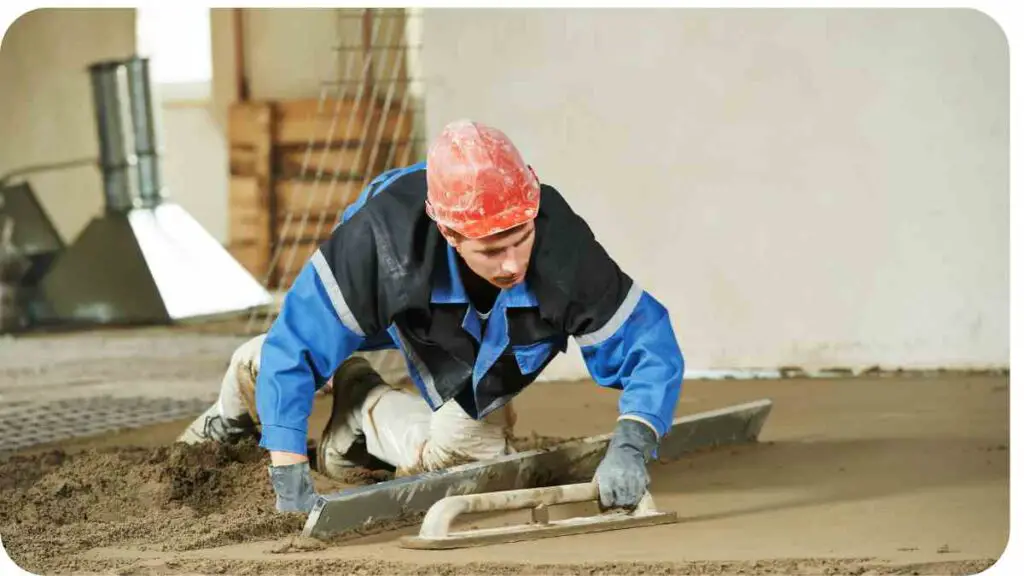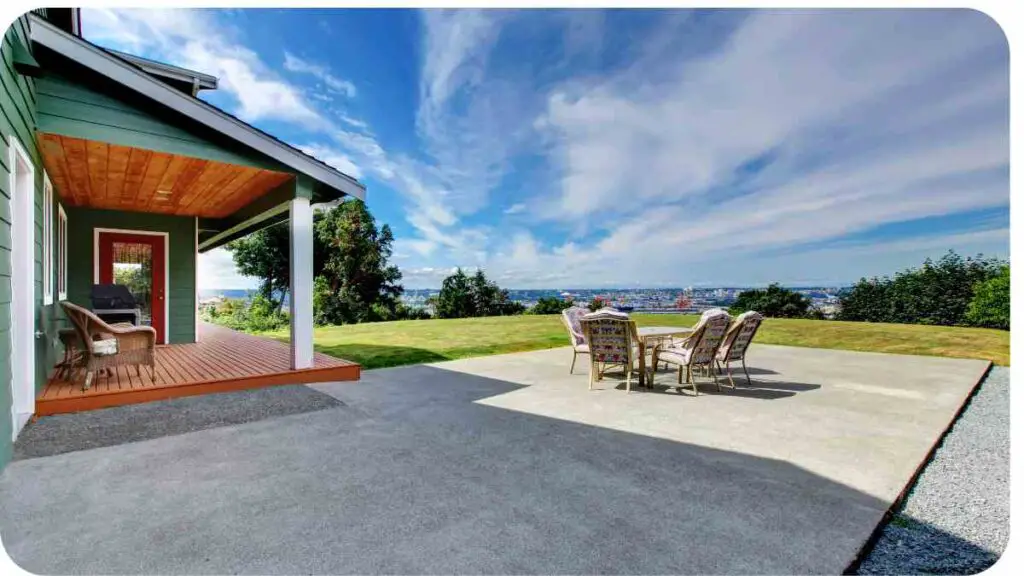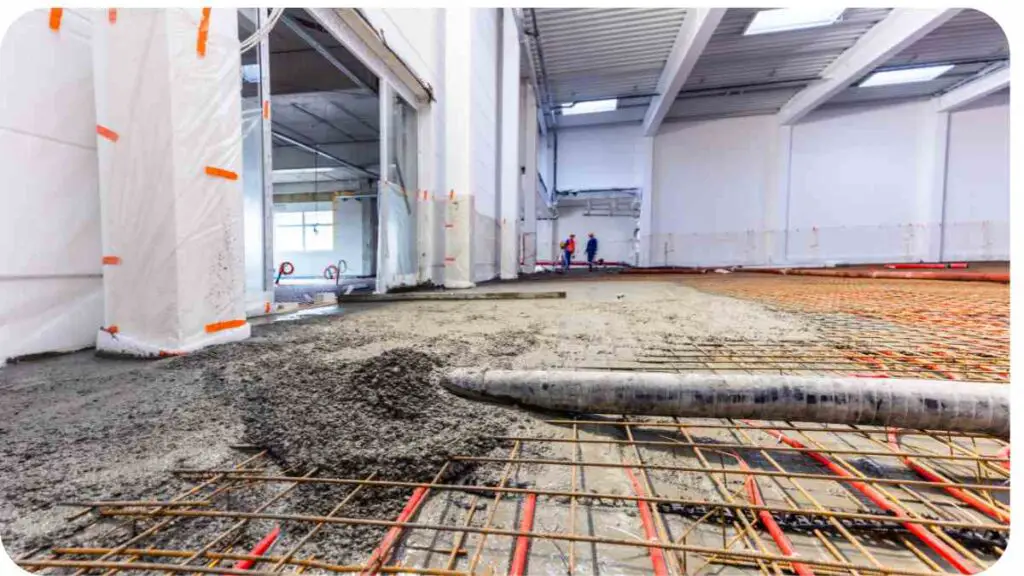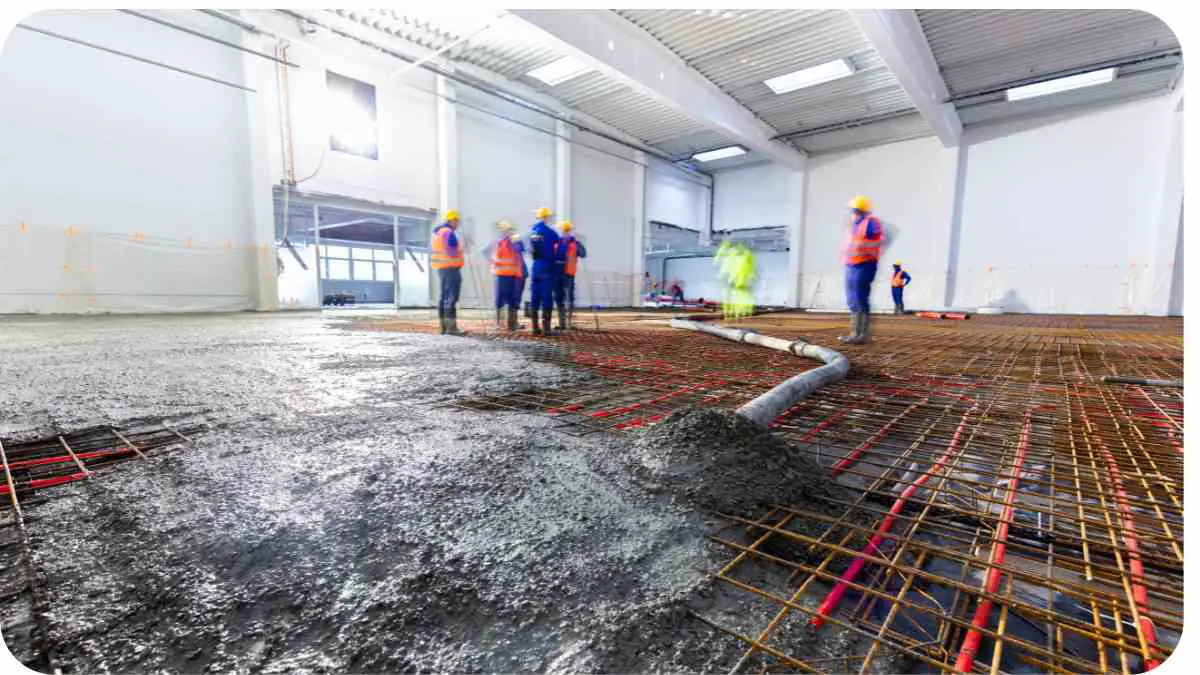Building a concrete backyard floor can transform your outdoor space, providing durability and a clean, modern aesthetic. Whether you’re planning a patio, a pathway, or an entire outdoor living area, understanding the process of laying a concrete floor is essential.
In this guide, we’ll walk you through each step from planning and preparation to pouring, curing, and maintenance to help you create a solid foundation that lasts for years.
| Key Takeaways |
|---|
| 1. Plan thoroughly before starting your project. |
| 2. Choose the right concrete mix for durability. |
| 3. Properly prepare the site and set up forms. |
| 4. Follow correct pouring, leveling, and finishing techniques. |
| 5. Implement effective curing and maintenance practices. |
| 6. Consider environmental and safety aspects. |
| 7. Explore decorative options like coloring and sealing. |
| 8. Budget wisely and factor in all costs. |
| 9. Refer to detailed guides and resources for additional help. |
Understanding Concrete Floors

What are Concrete Floors?
Concrete floors are sturdy, versatile surfaces made from a mixture of cement, water, aggregates (like sand or gravel), and often additives for specific purposes. They are known for their strength and longevity, making them ideal for outdoor applications.
Building a backyard terrace requires careful planning and sturdy materials. Ensure your terrace stands strong against weather changes and supports outdoor activities effectively.
Benefits of Concrete Floors
Concrete floors offer several advantages:
- Durability: Resistant to wear and tear, weather, and heavy loads.
- Versatility: Can be customized with colors, textures, and finishes.
- Low Maintenance: Easy to clean and maintain compared to other flooring options.
Planning Your Concrete Backyard Floor

Assessing Your Space
Before starting, assess your backyard area where you plan to install the concrete floor. Consider the size, shape, and intended use of the space. This assessment helps determine the amount of concrete needed and any special considerations for the installation.
Determining Concrete Thickness
The thickness of your concrete floor depends on its intended use. For pedestrian areas like patios or pathways, a thickness of 4 inches is typical. However, for driveways or areas with heavy vehicle traffic, thicker concrete (usually 6 inches or more) is necessary to withstand the load.
Hosting a backyard party involves creating a welcoming atmosphere and arranging your space efficiently for guests to enjoy. Consider lighting, seating, and entertainment options for a memorable gathering.
Choosing the Right Concrete Mix
Selecting the appropriate concrete mix is crucial for the project’s success. Factors to consider include the type of aggregates, strength requirements, and any special additives (such as fiber reinforcement or admixtures for faster curing).
Preparing for Concrete Pour
Gathering Materials and Tools
Before pouring concrete, gather all necessary materials and tools:
- Concrete mix
- Water
- Wheelbarrow or concrete mixer
- Shovel and rake
- Level and float
- Forms and stakes
Site Preparation
Prepare the site by clearing it of debris, vegetation, and any obstacles. Ensure the ground is compact and level to provide a stable base for the concrete.
Setting Up Forms
Forms act as molds that define the shape and boundaries of your concrete slab. Use wood or metal forms secured with stakes to contain the concrete during pouring. Ensure the forms are straight, level, and well-supported to prevent leaks or shifting during pouring.
Choosing the right fruits for your backyard depends on climate and space. Discover which fruits thrive best in your area and enjoy homegrown flavors throughout the seasons.
Pouring Concrete
Mixing Concrete Properly
Follow the manufacturer’s instructions to mix the concrete thoroughly. Use a concrete mixer or mix by hand in a wheelbarrow, ensuring a consistent blend of cement, aggregates, and water.
Pouring Techniques
Pour the concrete evenly into the prepared forms, starting from one end and working your way across. Avoid stopping and starting during the pour to maintain a uniform surface.
Leveling and Finishing
Once poured, use a shovel, rake, or screed board to level the concrete surface. Then, use a float or trowel to smooth and finish the surface, removing any air pockets or imperfections.
Curing and Maintenance
Importance of Curing
Curing is a critical step that ensures the concrete achieves its maximum strength and durability. Proper curing involves maintaining moisture and temperature conditions conducive to the hydration process of the cement. This process helps prevent cracking, improves surface hardness, and enhances overall durability.
Curing Techniques
There are several curing methods you can employ:
- Water Curing: Keep the concrete surface moist by spraying or ponding water.
- Plastic Sheeting: Cover the concrete with plastic sheeting to retain moisture.
- Curing Compounds: Apply curing compounds to seal moisture into the concrete surface.
Maintenance Tips
Maintaining your concrete backyard floor extends its lifespan and enhances its appearance:
- Regular Cleaning: Sweep or hose down the surface to remove dirt and debris.
- Sealing: Apply a concrete sealer to protect against stains, moisture penetration, and UV damage.
- Repairing Cracks: Promptly repair any cracks to prevent water ingress and further damage.
Planning a backyard wedding involves balancing budget and ambiance. Learn how to budget effectively for your special day while creating a beautiful outdoor setting for cherished memories.
Enhancing Your Concrete Floor

Adding Color or Texture
Enhance the aesthetics of your concrete floor by adding color or texture:
- Integral Color: Mix color pigments into the concrete mix for uniform color throughout.
- Stamped Concrete: Use stamps to create patterns or textures that mimic stone, brick, or tile.
- Exposed Aggregate: Expose decorative aggregates (like pebbles or glass) by washing away the top layer of concrete.
Sealing Options
Sealing your concrete floor provides additional protection and enhances its appearance:
- Acrylic Sealers: Ideal for interior floors or decorative surfaces.
- Epoxy Coatings: Provide a durable, high-gloss finish suitable for garages or high-traffic areas.
- Penetrating Sealers: Protect against moisture penetration while maintaining a natural look.
Common Issues and Troubleshooting
Cracks and Their Causes
Cracking is a common issue in concrete floors, caused by various factors:
- Shrinkage: As concrete cures and dries, it naturally shrinks, leading to surface cracks.
- Settlement: Uneven settling of the ground beneath the concrete can cause cracks.
- Temperature Changes: Extreme temperature fluctuations can induce thermal expansion and contraction, resulting in cracks.
Repairing Minor Damage
Address minor cracks or damage promptly to prevent them from worsening:
- Fillers and Sealants: Use concrete patching compounds or sealants designed for crack repair.
- Resurfacing: Apply a thin layer of fresh concrete or overlay to restore the surface.
Cost Considerations
Estimating Costs
Understanding the costs involved in building a concrete backyard floor helps you budget effectively:
- Materials: Calculate the cost of concrete mix, reinforcement materials (if needed), forms, and tools.
- Labor: Consider whether you’ll hire professionals or undertake the project yourself.
- Additional Costs: Factor in expenses for site preparation, sealing materials, and any decorative finishes.
Building a cost-effective backyard fence requires strategic planning and durable materials. Explore how to construct a sturdy barrier that enhances privacy and security without breaking the bank.
Budgeting Tips
To manage costs efficiently, consider these budgeting tips:
- Plan Ahead: Research and estimate costs accurately before starting the project.
- DIY vs. Professional Help: Assess whether you have the skills and time to DIY or if hiring professionals is more cost-effective.
- Prioritize Essentials: Allocate funds primarily to essential materials and tools, then consider optional enhancements based on your budget.
Environmental Considerations
Eco-friendly Practices
Implementing eco-friendly practices when building a concrete floor contributes to sustainability:
- Recycled Materials: Use recycled aggregates or fly ash in the concrete mix to reduce environmental impact.
- Energy Efficiency: Opt for energy-efficient tools and equipment during construction.
- Water Management: Minimize water usage and manage runoff responsibly.
Recycling Concrete Waste
Reduce waste and environmental impact by recycling concrete:
- Crushed Concrete: Use crushed concrete as aggregate for new projects or as a base material.
- Reuse on Site: Crush and reuse demolished concrete on-site for landscaping or sub-base applications.
Safety Tips
Protective Gear
Ensure safety during concrete construction with appropriate protective gear:
- Safety Glasses and Gloves: Protect against concrete splashes and skin irritation.
- Boots: Wear sturdy, slip-resistant boots to prevent slips and falls on wet surfaces.
- Respiratory Protection: Use a dust mask or respirator when mixing or handling dry concrete.
Handling Concrete Safely
Follow safety protocols to handle concrete safely:
- Lifting Techniques: Lift and carry bags of concrete mix properly to avoid strain or injury.
- Avoid Contact with Skin: Concrete can cause skin irritation or burns—wear long sleeves and wash exposed skin immediately.
- Proper Cleanup: Clean tools and equipment promptly to prevent concrete from hardening and becoming difficult to remove.
FAQs about Concrete Backyard Floors
What is the lifespan of a concrete floor?
Concrete floors can last for decades with proper installation and maintenance. Factors such as climate conditions, usage patterns, and maintenance practices influence longevity.
Can I DIY a concrete floor?
Yes, DIYing a concrete floor is possible with the right tools, materials, and knowledge. However, consider your skill level and the complexity of the project before proceeding.
How do I prevent cracks in my concrete floor?
To minimize cracking, ensure proper site preparation, use reinforcement materials if necessary, control water content during mixing, and implement effective curing techniques.
Conclusion
Building a concrete backyard floor is a rewarding project that enhances your outdoor space’s functionality and aesthetics. By following proper planning, preparation, and construction techniques, you can create a durable and visually appealing surface that withstands the test of time. Remember to prioritize safety, environmental considerations, and maintenance to ensure your concrete floor remains in top condition for years to come.
Whether you’re designing a patio for entertaining, a pathway for convenience, or a durable surface for outdoor activities, the versatility of concrete offers endless possibilities. With careful attention to detail and the right tools, you can achieve a professional-quality result that enhances your home’s value and enjoyment.
Tables
Here are some tables that can help clarify key points in building a concrete backyard floor:
Table 1: Common Concrete Mix Ingredients
| Ingredient | Purpose |
|---|---|
| Cement | Binds the concrete mix together |
| Aggregates | Provide strength and durability |
| Water | Initiates the chemical reaction in cement |
| Admixtures | Enhance specific properties of concrete |
Table 2: Types of Concrete Finishes
| Finish Type | Description |
|---|---|
| Broom Finish | Textured finish suitable for driveways and pathways |
| Exposed Aggregate | Decorative finish with exposed stones or glass for added aesthetics |
| Stamped Concrete | Patterned finish that mimics materials like brick, slate, or tile |
These tables provide a clear overview of concrete mix ingredients and popular finish options, aiding in decision-making during your project.
Further Reading
Here are some additional resources to further guide you in building a concrete backyard floor:
- MasterClass – DIY Concrete Patio Guide: Explore comprehensive guides and tips for DIY concrete patio projects.
- Lowe’s – How to Build a Concrete Pad: Step-by-step instructions on constructing a concrete pad for various outdoor applications.
- B&Q DIY – How to Plan a Concrete Path, Patio, or Driveway: Planning tips and advice for designing and executing concrete paths, patios, or driveways.
FAQs about Concrete Backyard Floors
Here are common questions about building and maintaining concrete backyard floors:
What is the lifespan of a concrete floor?
Concrete floors can last for decades with proper installation and maintenance. Factors such as climate conditions, usage patterns, and maintenance practices influence longevity.
Can I DIY a concrete floor?
Yes, DIYing a concrete floor is possible with the right tools, materials, and knowledge. However, consider your skill level and the complexity of the project before proceeding.
How do I prevent cracks in my concrete floor?
To minimize cracking, ensure proper site preparation, use reinforcement materials if necessary, control water content during mixing, and implement effective curing techniques.
What are the best practices for curing a concrete floor?
Proper curing involves maintaining moisture levels and temperature conditions conducive to the hydration process of the cement. Methods include water curing, plastic sheeting, and curing compounds.
How can I enhance the appearance of my concrete floor?
You can enhance your concrete floor by adding color or texture through integral coloring, stamped patterns, or exposed aggregates. Sealing options also help protect and beautify the surface.
These questions and answers cover essential aspects of concrete floor construction, maintenance, and enhancement. If you have more specific inquiries or need further clarification, feel free to ask!

I am Hellen James, a landscape architect. For many years I have written about landscaping for various publications; however, recently decided to focus my writing on personal experience as a profession.

